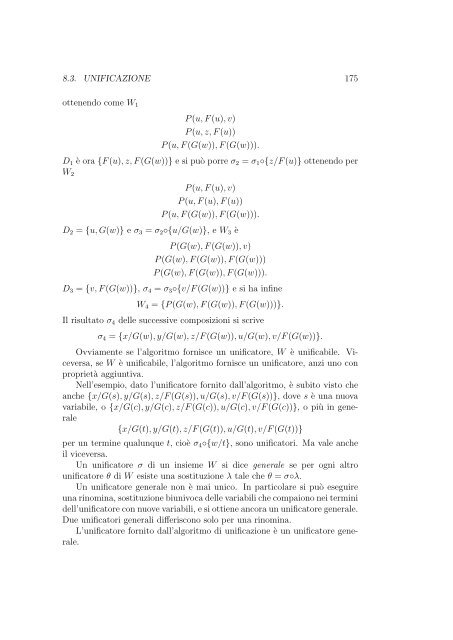Logica Matematica Corso di Laurea in Informatica ... - Mbox.dmi.unict.it
Logica Matematica Corso di Laurea in Informatica ... - Mbox.dmi.unict.it
Logica Matematica Corso di Laurea in Informatica ... - Mbox.dmi.unict.it
You also want an ePaper? Increase the reach of your titles
YUMPU automatically turns print PDFs into web optimized ePapers that Google loves.
8.3. UNIFICAZIONE 175<br />
ottenendo come W1<br />
P (u, F (u), v)<br />
P (u, z, F (u))<br />
P (u, F (G(w)), F (G(w))).<br />
D1 è ora {F (u), z, F (G(w))} e si può porre σ2 = σ1◦{z/F (u)} ottenendo per<br />
W2<br />
P (u, F (u), v)<br />
P (u, F (u), F (u))<br />
P (u, F (G(w)), F (G(w))).<br />
D2 = {u, G(w)} e σ3 = σ2◦{u/G(w)}, e W3 è<br />
P (G(w), F (G(w)), v)<br />
P (G(w), F (G(w)), F (G(w)))<br />
P (G(w), F (G(w)), F (G(w))).<br />
D3 = {v, F (G(w))}, σ4 = σ3◦{v/F (G(w))} e si ha <strong>in</strong>f<strong>in</strong>e<br />
W4 = {P (G(w), F (G(w)), F (G(w)))}.<br />
Il risultato σ4 delle successive composizioni si scrive<br />
σ4 = {x/G(w), y/G(w), z/F (G(w)), u/G(w), v/F (G(w))}.<br />
Ovviamente se l’algor<strong>it</strong>mo fornisce un unificatore, W è unificabile. Viceversa,<br />
se W è unificabile, l’algor<strong>it</strong>mo fornisce un unificatore, anzi uno con<br />
proprietà aggiuntiva.<br />
Nell’esempio, dato l’unificatore forn<strong>it</strong>o dall’algor<strong>it</strong>mo, è sub<strong>it</strong>o visto che<br />
anche {x/G(s), y/G(s), z/F (G(s)), u/G(s), v/F (G(s))}, dove s è una nuova<br />
variabile, o {x/G(c), y/G(c), z/F (G(c)), u/G(c), v/F (G(c))}, o più <strong>in</strong> generale<br />
{x/G(t), y/G(t), z/F (G(t)), u/G(t), v/F (G(t))}<br />
per un term<strong>in</strong>e qualunque t, cioè σ4◦{w/t}, sono unificatori. Ma vale anche<br />
il viceversa.<br />
Un unificatore σ <strong>di</strong> un <strong>in</strong>sieme W si <strong>di</strong>ce generale se per ogni altro<br />
unificatore θ <strong>di</strong> W esiste una sost<strong>it</strong>uzione λ tale che θ = σ◦λ.<br />
Un unificatore generale non è mai unico. In particolare si può eseguire<br />
una r<strong>in</strong>om<strong>in</strong>a, sost<strong>it</strong>uzione biunivoca delle variabili che compaiono nei term<strong>in</strong>i<br />
dell’unificatore con nuove variabili, e si ottiene ancora un unificatore generale.<br />
Due unificatori generali <strong>di</strong>fferiscono solo per una r<strong>in</strong>om<strong>in</strong>a.<br />
L’unificatore forn<strong>it</strong>o dall’algor<strong>it</strong>mo <strong>di</strong> unificazione è un unificatore generale.




![Introduzione ai sistemi Wiki [PDF] - Mbox.dmi.unict.it](https://img.yumpu.com/16413205/1/184x260/introduzione-ai-sistemi-wiki-pdf-mboxdmiunictit.jpg?quality=85)











